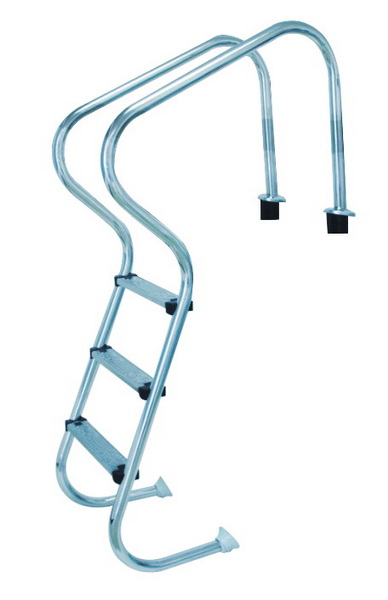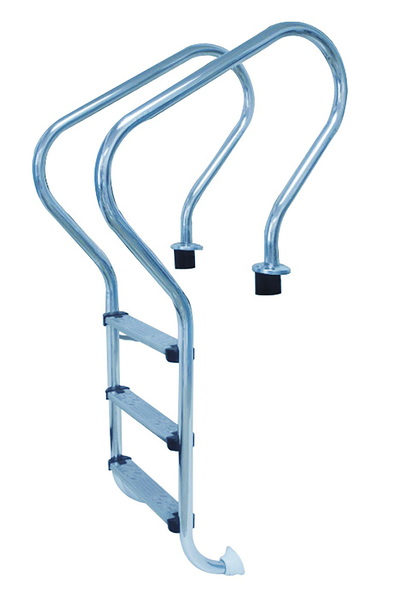Views: 222 Author: Tina Publish Time: 2025-10-17 Origin: Site








Content Menu
● Overview of a typical Coleman-style pool ladder
● Key design considerations and materials
● Step-by-step assembly and installation tips
● Safety checks and maintenance
● OEM considerations for manufacturers
● Common issues and troubleshooting
● FAQ
>> 1. What materials are best for pool ladder rails?
>> 2. How should a pool ladder be mounted on a concrete wall?
>> 3. What is the typical weight rating for residential pool ladders?
>> 4. How often should pool ladders be inspected for safety?
>> 5. Can ladders be customized to fit niche pool shapes?
As a Chinese manufacturer specializing in premium pool filtration and related solutions, we understand the importance of reliable accessories like pool ladders. While Coleman is a well-known brand in pool equipment, this article focuses on practical guidance inspired by how Coleman-style ladders are designed and installed, and offers OEM considerations for foreign brands seeking high-quality ladder components. This guide will cover essential design features, materials, safety considerations, assembly steps, and troubleshooting tips to help you understand ladder construction principles that align with top-tier standards.

Coleman pool ladders are designed to provide safe access to residential in-ground and above-ground pools. They typically feature corrosion-resistant frames, non-slip steps, and secure mounting hardware. A standard ladder system usually comprises:
- A pair of vertical rails (often aluminum or reinforced steel with protective coatings)
- Rungs or steps with anti-slip surfaces
- Mounting brackets for secure attachment to the pool wall
- End caps, screws, and locking mechanisms for safety
Understanding these components helps in designing OEM ladders that meet international safety standards while fitting a variety of pool shapes and wall constructions.
- Material selection: Aluminum alloys for corrosion resistance, stainless steel fasteners for durability, and UV-resistant plastics for end caps and step surfaces.
- Coatings: Anodizing or powder coating to resist pool chemicals and saltwater environments.
- Rung design: Textured, non-slip surfaces; spacing that complies with local safety codes.
- Mounting compatibility: Backed by adjustable brackets to fit different wall thicknesses and pool designs.
- Weight rating and safety: Ladder should support typical adult loads with a safety factor; include handrails or grips where appropriate.
- Maintenance considerations: Easy-to-clean surfaces and accessible hardware for periodic inspection.
1) Gather all components: rails, rungs, mounting brackets, fasteners, end caps, and installation templates.
2) Inspect parts for damage and verify measurements align with the pool opening.
3) Attach the mounting brackets to the pool wall using appropriate anchors and fasteners for the wall material (concrete, plaster, or fiberglass).
4) Insert rails through brackets and tighten to spec to avoid movement.
5) Attach rungs to rails at the recommended spacing, ensuring all fasteners are secure and even.
6) Install end caps and any safety covers or locking mechanisms.
7) Test fit the ladder in the pool opening, ensuring smooth operation and stable stance.
8) Conduct a safety check (see section below) and make any necessary adjustments.
If you're producing ladders for OEM customers, provide detailed installation diagrams and multi-language instructions to facilitate global adoption.

- Inspect ladder mounting points for loose screws or cracks every few months, especially in harsh climates.
- Check for corrosion on rails and fasteners; replace any compromised parts promptly.
- Ensure steps remain non-slip and free of sharp edges.
- Verify load ratings and ensure the ladder is securely attached before each use.
- Store ladders properly when not in use to minimize wear and tear.
- Compliance: Align ladder design with international safety standards (e.g., UL, EN, ISO) and local regulations.
- Customization: Offer adjustable wall-mix options and a range of coatings to fit client branding.
- Quality control: Implement rigorous QC steps for coating thickness, corrosion resistance, and load testing.
- Documentation: Provide BOMs, installation manuals, and maintenance guidelines in multiple languages.
- Sourcing: Ensure a steady supply of corrosion-resistant materials and secure manufacturing capacity for large orders.
- Loose mounting brackets: re-tighten and verify anchors; consider using longer anchors for better grip in concrete.
- Slippery steps: replace with textured inserts or anti-slip treads.
- Rust on fasteners: switch to stainless steel or coated fasteners.
- Misalignment: re-check wall thickness measurements and adjust brackets accordingly.
This guide presented a practical framework for understanding Coleman-style pool ladders, focusing on materials, design considerations, assembly steps, safety checks, and OEM considerations. While this article references Coleman-inspired design principles, it emphasizes quality, safety, and adaptability for OEM manufacturing in the pool filtration and accessories sector.

- Use corrosion-resistant aluminum or stainless steel, with UV-stable plastics for end caps and non-slip steps.
- Use concrete anchors, follow the wall thickness, and ensure brackets are securely attached with appropriate fasteners.
- Most residential ladders are rated for adult use with a safety factor; confirm per product spec and local codes.
- Inspect every few months and after major storms or impacts; replace corroded parts promptly.
- Yes, OEM designs can offer adjustable mounting and customizable coatings to match branding and wall geometry.
This guide explains how to safely increase pressure on a pool pump by restoring healthy water flow. Learn to diagnose low pressure, clean baskets and filters, fix air leaks, adjust valves and pump speed, and know when equipment upgrades or gauge replacement are necessary.<br />
This in‑depth guide explains how much it costs to replace a pool pump, covering typical price ranges, pump types, labor charges, and long‑term energy savings. Learn when to repair vs replace, DIY vs professional options, and how OEM pump and filter solutions can reduce lifetime ownership cost.<br />
Learn exactly how long to run a pool pump daily for crystal‑clear, safe water and lower energy bills. This in‑depth guide explains turnover, seasonal adjustments, single‑ vs variable‑speed schedules, energy‑saving tips, and practical examples, plus answers to common runtime questions.
This in‑depth guide explains the real reasons your swimming pool pump is not working, from power and priming issues to clogged impellers, dirty filters, and motor failures. Learn step‑by‑step troubleshooting, key maintenance tips, and when to repair or replace your pool pump.
Learn how to remove a pool pump motor safely and efficiently with this step‑by‑step guide. Discover the tools you need, how to disconnect power and plumbing, when to call a pro, and how OEM filter and pump solutions can support overseas pool brands and wholesalers.<br />
This article introduces leading Pool Cleaning Equipment Manufacturers and Suppliers in the UK, outlines their key products, and explains how international brands can combine UK distributors with Chinese OEM factories to build competitive, high‑quality private‑label pool cleaning and filtration lines.
This article outlines the leading Pool Cleaning Equipment Manufacturers and Suppliers in America, explains key product categories such as sand filters, pumps, and robotic cleaners, and shows how importers can combine U.S. brands with Chinese OEM partners to build competitive, high‑margin pool equipment portfolios.<br />
This article introduces the European market for pool equipment and accessories, profiles key Pool Cleaning Equipment Manufacturers and Suppliers, and explores OEM opportunities for Chinese factories producing sand filters, pumps, cleaners and LEDs for European brands and wholesalers.<br />
This article profiles top Pool Filter Valve Manufacturers and Suppliers in Canada, including Praher Plastics, global brands like Hayward and Carvin, and leading distributors. It explains key valve types, buying factors, and how foreign OEM factories can partner with Canadian suppliers for complete pool filtration solutions.<br />
Discover top Pool Filter Valve Manufacturers and Suppliers in Korea, from Korea Filter to SEDA, offering innovative multiport valves, OEM services, and eco-friendly designs for global pools. Explore advancements, certifications, and FAQs in this comprehensive guide to superior filtration solutions.
This article introduces leading Pool Filter Valve Manufacturers and Suppliers in Japan and Asia, covering valve types, key Japanese pool brands, OEM opportunities, and application segments. It explains how advanced engineering, strict quality control, and strong visual marketing help exporters win global pool projects.
This article introduces the main types of Pool Filter Valve Manufacturers and Suppliers serving Russia, including local distributors, industrial filter producers, global brands, and Chinese OEM partners. It explains key selection criteria, product ranges, and OEM opportunities for Russian pool projects.<br />
This article introduces the leading Pool Filter Valve Manufacturers and Suppliers in Australia, explains common valve types and technical features, highlights major distributors and OEM opportunities, and offers practical tips for international buyers sourcing compatible filtration valves and systems.
This article introduces Italy’s leading Pool Filter Valve Manufacturers and Suppliers, detailing their technologies, materials, OEM services, and application scenarios. It explains how Italian valves integrate with sand, DE, and cartridge filters and why global brands choose Italian partners for premium pool filtration solutions.<br />
This article introduces the Portuguese market for pool filtration equipment and highlights how local specialists, European brands, and Chinese OEM Pool Filter Valve Manufacturers and Suppliers cooperate to serve residential and commercial pools, offering multiport valves, filters, pumps, and customized OEM solutions.<br />
This guide explains how to backwash a sand pool filter step by step, when to do it based on pressure readings, and how long to run backwash and rinse cycles. It also covers common mistakes, signs that filter sand needs replacement, and key differences among sand, DE, and cartridge filters.
This article explains how often to change or clean pool filters by type, using pressure-gauge thresholds and real-world conditions. It covers cartridge, sand, and DE filter intervals, step-by-step maintenance, lifespan signs, seasonal planning, and how OEM-sized systems can reduce maintenance while keeping water crystal clear.
This in‑depth guide explains how long pool filter cartridges last, what really affects their lifespan, and the key signs it is time to replace them. Learn practical maintenance tips, filter comparisons, and OEM insights for brands, wholesalers, and pool professionals.<br />
This guide explains how to change the sand in a pool filter step by step, from shutdown and disassembly to removing old sand, inspecting laterals, adding new media, and restarting the system. It covers safety gear, sand selection, backwashing, and common FAQs for clear, safe DIY maintenance.
This article explains practical ways to hide pool filters and equipment using landscaping, fences, sheds, benches, faux rocks, and acoustic barriers. It highlights safety clearances, ventilation, and visual media ideas, helping homeowners and buyers integrate filtration systems into attractive backyards.
